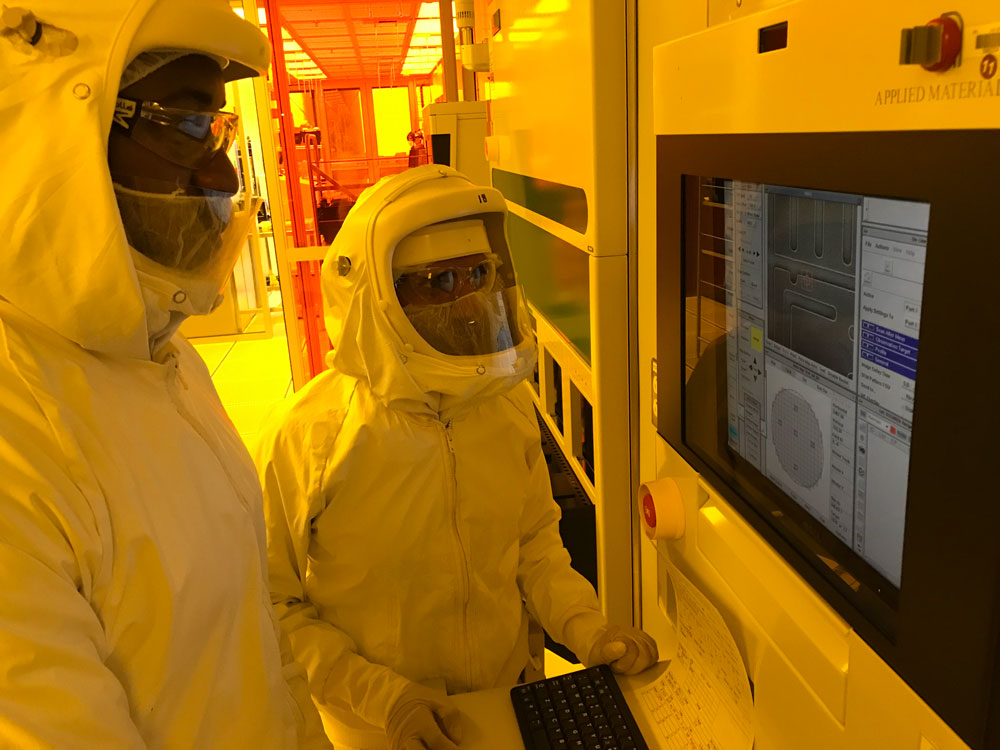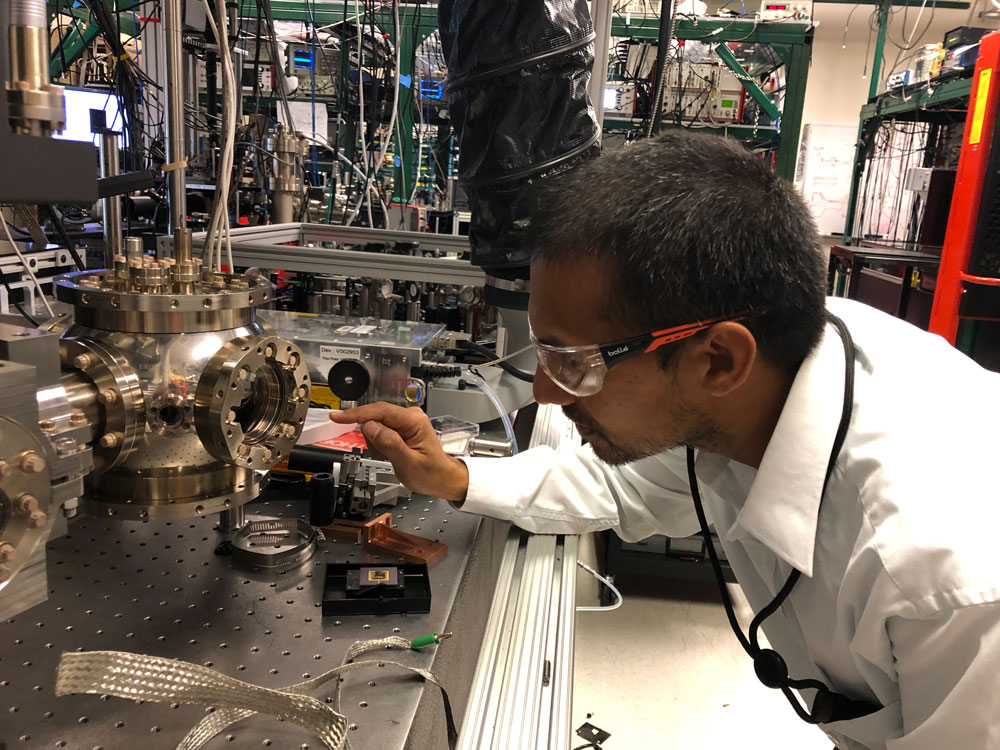Bishnu Khanal: Unlikely chemist

Sandia research and development manager Bishnu Khanal was recently honored with the Most Promising Asian American Engineer of Year award for his work in next-generation optical lithography process development for numerous technologies, along with his deep-reaching community service.
According to Asian American Engineer of Year, Bishnu was selected for his technical leadership and contributions in nanotechnology, semiconductor device fabrication and materials science.
“This recognition means a lot to me, and I’m so proud to be part of it,” Bishnu said. “Coming from a remote village in Nepal, ending up at Sandia Labs and then receiving this award is truly my honor.”
The annual award recognizes distinguished professionals who exhibit leadership, technical achievement and public service in their fields.
From humble beginnings
The Himalayans thrust skyward where Nepal, China and India meet. At the base of this rugged range lies the small village of Gulariya in western Nepal where Bishnu grew up. He describes his life there as primitive. “It was and still is a very simple agrarian way of life, where crops and livestock goods are sold in a central market,” he said. “That’s the community focus. My parents never attended school and my mom still uses currency based on color, size and weight.”
Despite his limited educational opportunities, Bishnu’s parents enthusiastically encouraged his schooling at every level. “Our shared classroom growing up was under a big tree, and if the weather was bad, we didn’t have lessons,” he said. “They made sure I attended every day that classes were held and that I completed all of my lessons.”
Through his basic studies, Bishnu became interested in science and math and the problem-solving methodologies that came with them. His high school math and science teachers, Shambhu Gautam and Bijay Mishra, recognized Bishnu’s potential and began structuring his assignments accordingly, thus encouraging his problem-solving abilities. “They helped build my interest and fundamental understanding of science and math,” he said.
His educational path seems serendipitous. “I had no big dream or grand plans when I enrolled in college in Nepal, but I really started enjoying chemistry and then organic chemistry,” Bishnu said. “I thought about eventually teaching. That’s all I knew. I really had no notion of what else was out there.”
As Bishnu completed his undergraduate chemistry work at Tribhuvan University, he felt the next logical step would be a master’s degree. Once Bishnu completed his master’s degree in 2003, he thought the next step would be a doctorate in chemistry, opening even bigger doors to his future.
Bishnu’s world opens up
“I didn’t know what came after earning my master’s, but a Ph.D. seemed like the next step,” Bishnu said. “Honestly, I never thought, ‘I’m going to get my Ph.D. and work in a national laboratory in the U.S.’ I didn’t know such opportunity existed.”
Bishnu spent the next couple of years as an undergraduate and graduate chemistry lecturer at various colleges in Kathmandu, Nepal. In 2005, he applied and was accepted by Rice University in Houston, to pursue his doctorate in chemistry and nanotechnology. There, he excelled in nanomaterials and nanotechnology research, garnering national awards and fellowships. He also was named a visiting graduate student at Massachusetts Institute of Technology. Bishnu was hitting his stride.
He joined Los Alamos National Laboratory in 2009 for his postdoctoral research on synthesis and spectroscopic study of semiconductor quantum dots and quantum rods. While at Los Alamos, Bishnu was selected as a director’s postdoctoral fellow for his outstanding research proposals and achievements.
After a brief period as a research and development engineer at Micron Technology in Boise, Idaho, Bishnu joined Intel Corp. in 2011 as a research and development process engineer. There, he worked on process development for several technology nodes, installed and qualified process equipment and led advanced technology transfers to Intel facilities in the U.S. and abroad.
The recipient of several academic and professional awards, Bishnu was widely considered a rising star in his field and, again, on the move.
Settling in at Sandia
In 2018, Bishnu joined the Labs to lead advanced optical photolithography research and development activities at Sandia’s Microsystems Engineering, Science and Applications, or MESA, division. He has quickly become a primary innovator for patterning process development focusing on radiation-hardened implements for several technologies, including complementary metal-oxide semiconductors, silicon photonics and quantum computing.

Bishnu also is a key member of numerous programs focusing on microelectronics and micro-electromechanical system development. He leads several fundamental science research projects in nanotechnology in collaboration with other scientists inside and outside of Sandia.
In 2022, Bishnu was selected to lead the Materials Mechanics and Tribology department as a research and development manager. He leads a diverse team of scientists, engineers, postdoctoral researchers, students and technologists working on developing a fundamental understanding of mechanical behavior of materials and operationalizing this understanding to resolve engineering challenges.
Bishnu has found professional energy in managing his team toward its mission goals. “There’s something rewarding in stepping outside of problem-solving on my own,” he said. “Now our entire team is solving problems together and that’s even more exciting and brings a higher impact to our national security mission.”
Paying it forward
His many accomplishments aside, Asian American Engineer of the Year also selected Bishnu for the award based on his public service efforts. Bishnu is establishing a trust with his personal funds in his parents’ names to support underprivileged students in his Nepal village. “We’ll have set criteria for selecting students in a local public school to help provide things like school supplies and clothes — things that I needed growing up,” he said. “We are targeting three to five students a year.”
Bishnu also serves his local Albuquerque community, volunteering in schools for kids’ fundraising fun runs and as a science fair judge. And he mentors New Mexico high school students for a two-week summer residential science, technology, engineering and mathematics program. “Some kids just need that little extra support, like I did,” he said. “Who knows what they can grow up to accomplish?”
About Asian American Engineer of the Year
The Asian American Engineer of the Year award is an annual national event that honors professionals and their leadership, technical achievements and public services. Asian American Engineer of the Year was first introduced in 2002 as a part of the National Engineers Week (DiscoverE) Program and has since become a forum for corporate America, academia and government entities in promoting STEM activities. Past awardees include Nobel laureates, academia, key corporate executives and astronauts.